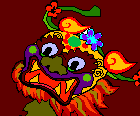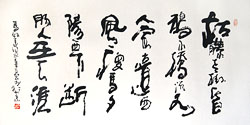China
CultureQuest

|
Go
on a dig with your students to China, using both digital tools and Chinese
brushwork to learn about the art and culture of China. |
 |
This
unit kicks off with a brainstorming session, eliciting from the kids what
“culture” is, and how they think Chinese culture may be similar to or
different from their own.
• Start
a list on the board of what they know about China, from there branch off into
what they might wish to learn about China. Individually or in small groups,
students choose what topic on the list (or another they might have thought of)
that they would like to research. It is very important that the kids pick a
topic they are really interested in because they will be focusing on it for
several weeks. Team members need to choose related subtopics they will be
responsible for.
Research
and Writing
•
The students register on Filamentality http://kn.pacbell.com/wired/fil/
Filimentality
is a web based fill-in-the-blank tool that guides them through picking a topic,
searching it on the web, finding relevant Internet links and creating learning
activities.
•
The students are given a copy of the rubric that will be used for assessing
their research report. See and revise the attached “China
Report Rubric” or make your own on
Rubistar, a free tool to help teacher create rubrics for project-based-learning
activities. The link for Rubistar is http://rubistar.4teachers.org/index.php
•
At least 2- 4 class sessions are dedicated to allowing the students to find
relevant sites, write short reviews of the sites, take notes, and word process
their China CultureQuest reports.
Chinese
Calligraphy and Brush Painting
•
The students will visit the following sites for background information and
visual aides:
Introduction
to Chinese Brush Painting http://asia-art.net/chinese_tech_brush.html
Learn
about a “Virtual Chinese Brush” http://people.brandeis.edu/~rossgir/
Appreciation
& history of Chinese Calligraphy http://chinapage.com/calligraphy.html
Seven
sequential steps in writing strokes http://chinavoc.com/arts/calligraphy/sevenstep.asp
•
Next, students use an online English-Chinese dictionary to find words relevant
to the China CultureQuest research topic.
English-Chinese
Dictionary http://ok88.com/go/svc/ecdict.html
•
Get a Chinese Name inspired by your English name at http://mandarintools.com/
•
Students practice using the Chinese brush with tempera paint, drawing and
writing Chinese words they found in the Internet research
Collage
•
For homework, students collect digital and “physical” images and ephemera
related to their China CultureQuest topic. For example, they can collect Chinese
menus, articles in magazines, travel brochures, etc.
•
To illustrate their topic, the students create an 8” x 10” collage using the
collected ephemera. They practice and apply Chinese characters and calligraphy
to their collage, using cut tag board or paper for the base of the
collage. Scissors and glue stick are used to separate the image elements and
glue them in position.
•
Chinese characters, calligraphy and drawings are applied to the collages using
Chinese bamboo brushes and tempera paint.
• The completed collages are scanned at 72dpi, scaled to 5” x 7” and
saved in .gif or .jpg file format.
• Dreamweaver or another web authoring program (or html) is used to make
web-based projects combining the students' illustrations, reports, and links to
relevant web sites about the culture of China.
Assessment:
Students
use the attached Self-Assessment Worksheet. The
teacher uses this document along with the report rubric, classroom observation,
and review of completed web project to assess and evaluate student
achievement throughout the unit.
Student
Work:
http://thebleedingedge.org/features/china_culture/8_china_culture_toc.html |